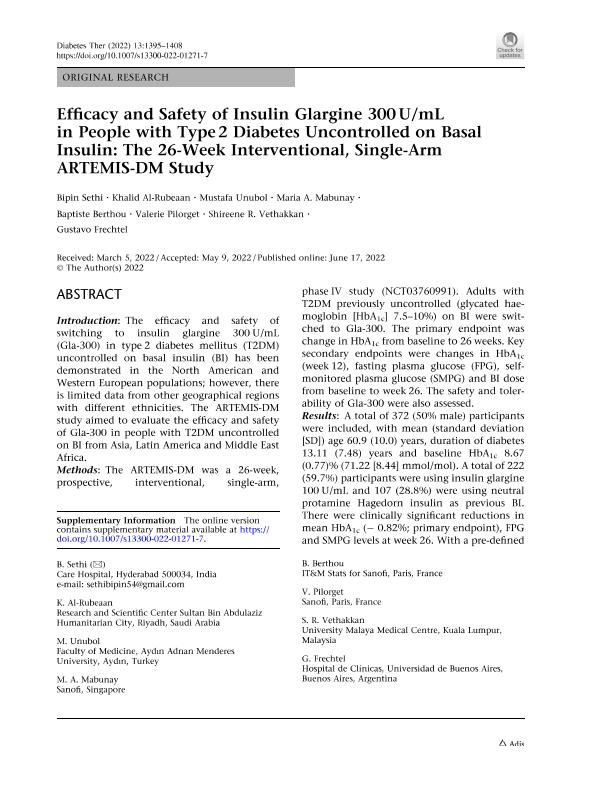Mostrar el registro sencillo del ítem
dc.contributor.author
Sethi, Bipin
dc.contributor.author
Al-Rubeaan, Khalid
dc.contributor.author
Unubol, Mustafa
dc.contributor.author
Mabunay, Maria A.
dc.contributor.author
Berthou, Baptiste
dc.contributor.author
Pilorget, Valerie
dc.contributor.author
Vethakkan, Shireene R.
dc.contributor.author
Frechtel, Gustavo Daniel

dc.date.available
2023-10-31T16:01:36Z
dc.date.issued
2022-07
dc.identifier.citation
Sethi, Bipin; Al-Rubeaan, Khalid; Unubol, Mustafa; Mabunay, Maria A.; Berthou, Baptiste; et al.; Efficacy and Safety of Insulin Glargine 300 U/mL in People with Type 2 Diabetes Uncontrolled on Basal Insulin: The 26-Week Interventional, Single-Arm ARTEMIS-DM Study; Springer; Diabetes Therapy; 13; 7; 7-2022; 1395-1408
dc.identifier.issn
1869-6953
dc.identifier.uri
http://hdl.handle.net/11336/216689
dc.description.abstract
Introduction: The efficacy and safety of switching to insulin glargine 300 U/mL (Gla-300) in type 2 diabetes mellitus (T2DM) uncontrolled on basal insulin (BI) has been demonstrated in the North American and Western European populations; however, there is limited data from other geographical regions with different ethnicities. The ARTEMIS-DM study aimed to evaluate the efficacy and safety of Gla-300 in people with T2DM uncontrolled on BI from Asia, Latin America and Middle East Africa. Methods: The ARTEMIS-DM was a 26-week, prospective, interventional, single-arm, phase IV study (NCT03760991). Adults with T2DM previously uncontrolled (glycated haemoglobin [HbA1c] 7.5–10%) on BI were switched to Gla-300. The primary endpoint was change in HbA1c from baseline to 26 weeks. Key secondary endpoints were changes in HbA1c (week 12), fasting plasma glucose (FPG), self-monitored plasma glucose (SMPG) and BI dose from baseline to week 26. The safety and tolerability of Gla-300 were also assessed. Results: A total of 372 (50% male) participants were included, with mean (standard deviation [SD]) age 60.9 (10.0) years, duration of diabetes 13.11 (7.48) years and baseline HbA1c 8.67 (0.77)% (71.22 [8.44] mmol/mol). A total of 222 (59.7%) participants were using insulin glargine 100 U/mL and 107 (28.8%) were using neutral protamine Hagedorn insulin as previous BI. There were clinically significant reductions in mean HbA1c (− 0.82%; primary endpoint), FPG and SMPG levels at week 26. With a pre-defined titration algorithm, mean Gla-300 dose increased from 27.48 U (0.35 U/kg) at baseline to 39.01 U (0.50 U/kg) at week 26. Hypoglycaemia events occurred in 20.4% of the participants; 1 (0.3%) participant had a severe hypoglycaemia event. Conclusion: In people with T2DM uncontrolled on previous BI, switching to Gla-300 with optimal titration guided by an algorithm was associated with improved glycaemic control and low incidence of hypoglycaemia across multiple geographic regions. ClinicalTrials.gov identifier: NCT03760991.
dc.format
application/pdf
dc.language.iso
eng
dc.publisher
Springer

dc.rights
info:eu-repo/semantics/openAccess
dc.rights.uri
https://creativecommons.org/licenses/by-nc/2.5/ar/
dc.subject
BASAL INSULIN
dc.subject
GLYCAEMIC CONTROL
dc.subject
HYPOGLYCAEMIA
dc.subject
INSULIN GLARGINE 300 U/ML
dc.subject
TYPE 2 DIABETES MELLITUS
dc.subject.classification
Endocrinología y Metabolismo

dc.subject.classification
Medicina Clínica

dc.subject.classification
CIENCIAS MÉDICAS Y DE LA SALUD

dc.title
Efficacy and Safety of Insulin Glargine 300 U/mL in People with Type 2 Diabetes Uncontrolled on Basal Insulin: The 26-Week Interventional, Single-Arm ARTEMIS-DM Study
dc.type
info:eu-repo/semantics/article
dc.type
info:ar-repo/semantics/artículo
dc.type
info:eu-repo/semantics/publishedVersion
dc.date.updated
2023-10-30T16:11:16Z
dc.identifier.eissn
1869-6961
dc.journal.volume
13
dc.journal.number
7
dc.journal.pagination
1395-1408
dc.journal.pais
Alemania

dc.journal.ciudad
Berlín
dc.description.fil
Fil: Sethi, Bipin. Care Hospital Hyderabad; India
dc.description.fil
Fil: Al-Rubeaan, Khalid. Research and Scientific Center Sultan Bin Abdulaziz Humanitarian City; Argentina
dc.description.fil
Fil: Unubol, Mustafa. Adnan Menderes Universitesi; Turquía
dc.description.fil
Fil: Mabunay, Maria A.. Sanofi; Singapur
dc.description.fil
Fil: Berthou, Baptiste. Sanofi; Francia
dc.description.fil
Fil: Pilorget, Valerie. Sanofi; Francia
dc.description.fil
Fil: Vethakkan, Shireene R.. University Malaya Medical Centre; Malasia
dc.description.fil
Fil: Frechtel, Gustavo Daniel. Consejo Nacional de Investigaciones Científicas y Técnicas. Oficina de Coordinación Administrativa Houssay. Instituto de Inmunología, Genética y Metabolismo. Universidad de Buenos Aires. Facultad de Medicina. Instituto de Inmunología, Genética y Metabolismo; Argentina. Universidad de Buenos Aires. Facultad de Medicina. Hospital de Clínicas General San Martín; Argentina
dc.journal.title
Diabetes Therapy
dc.relation.alternativeid
info:eu-repo/semantics/altIdentifier/url/https://link.springer.com/article/10.1007/s13300-022-01271-7
dc.relation.alternativeid
info:eu-repo/semantics/altIdentifier/doi/http://dx.doi.org/10.1007/s13300-022-01271-7
Archivos asociados
